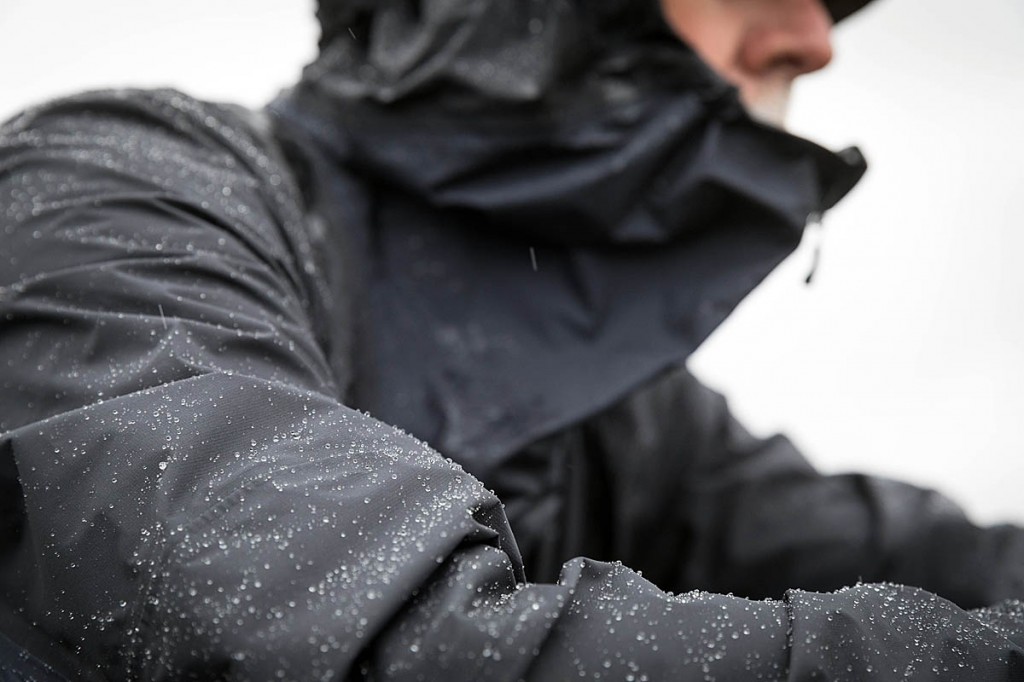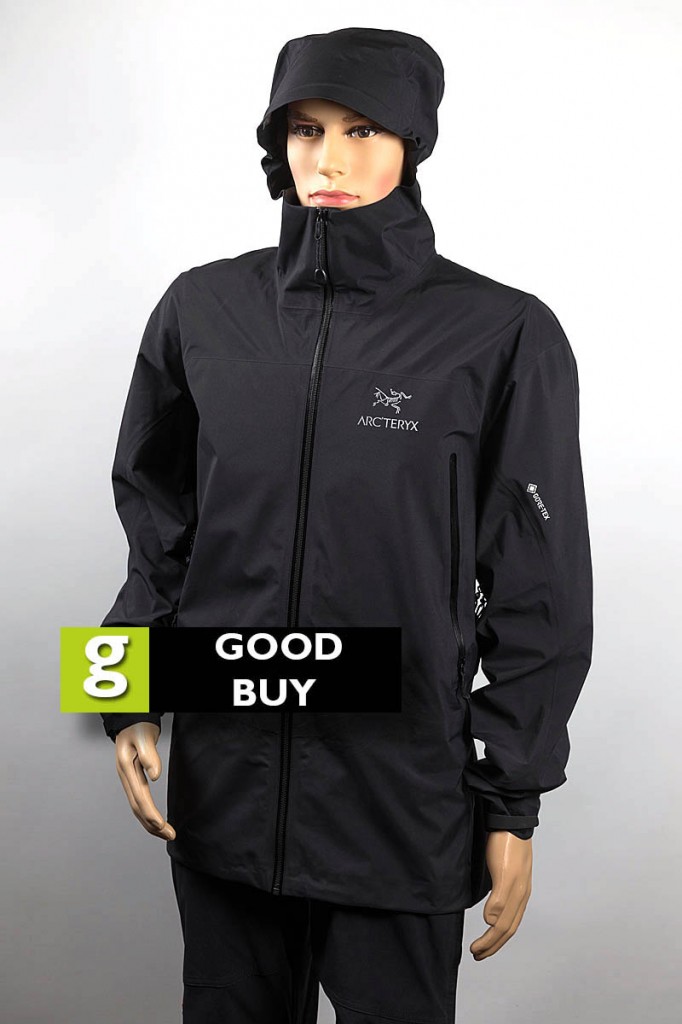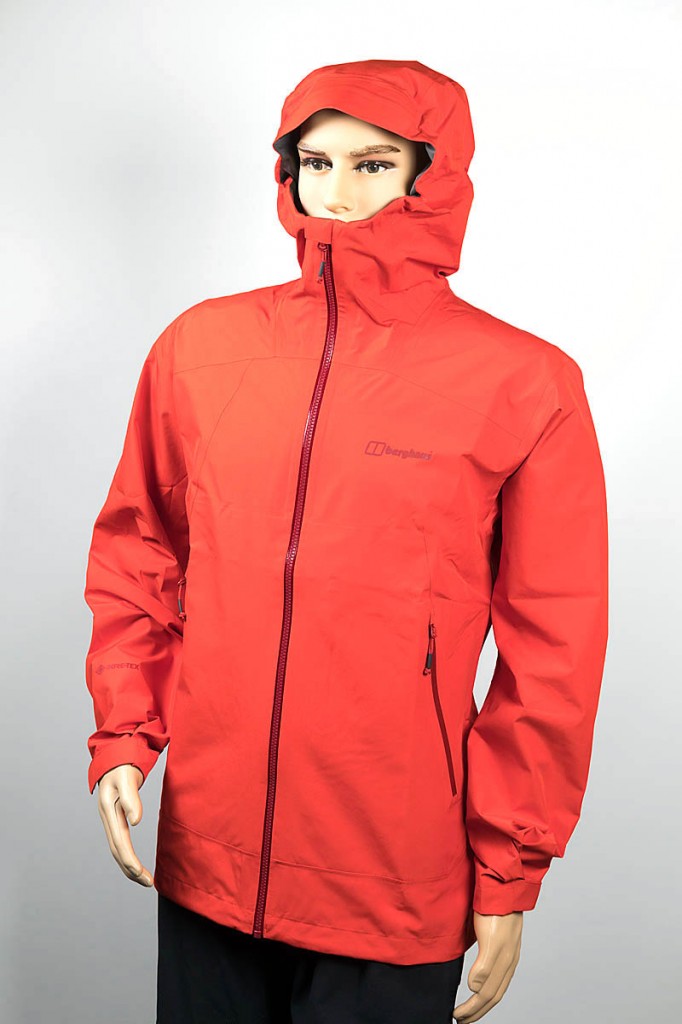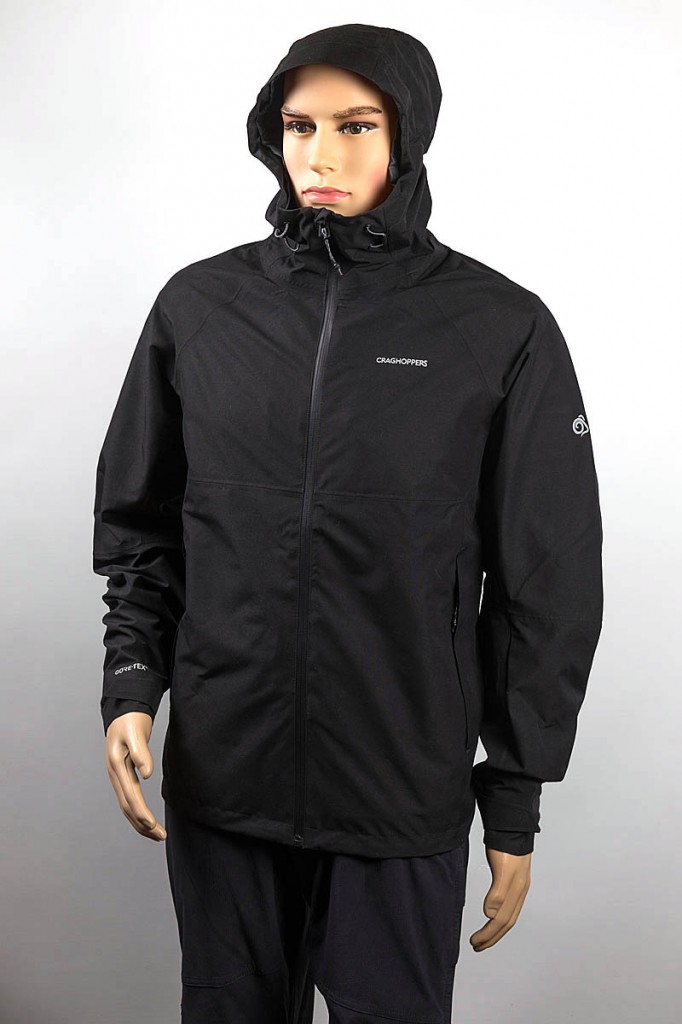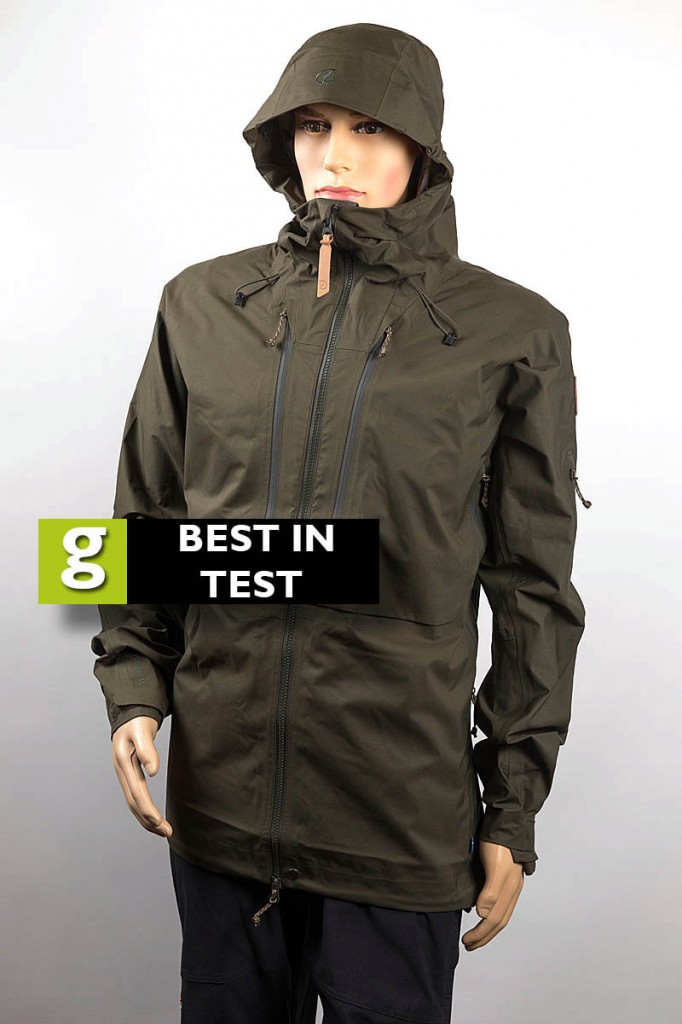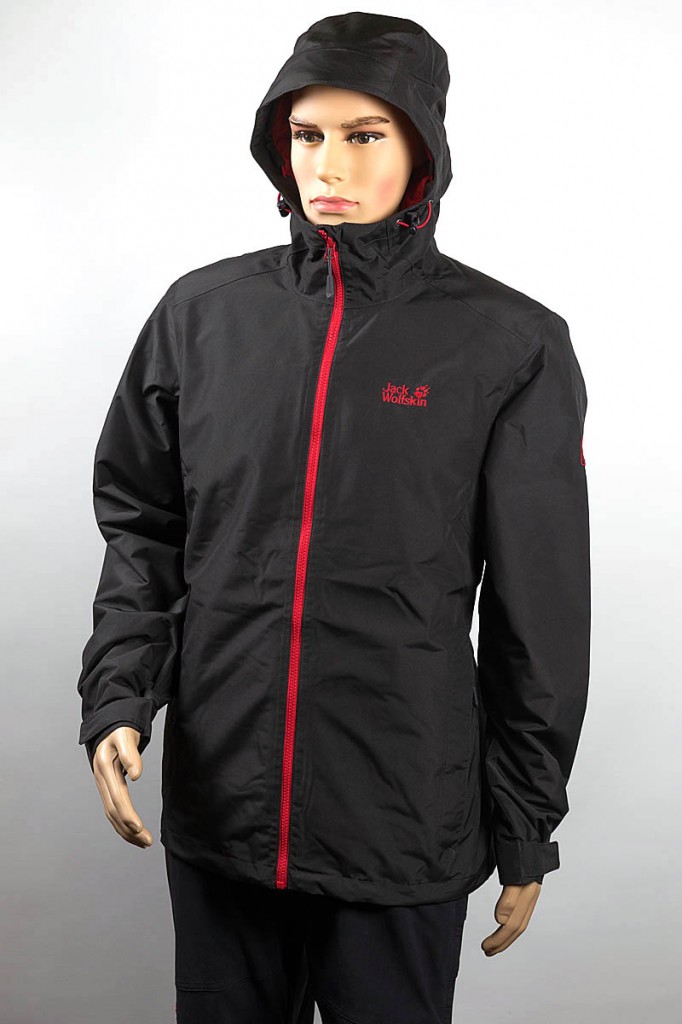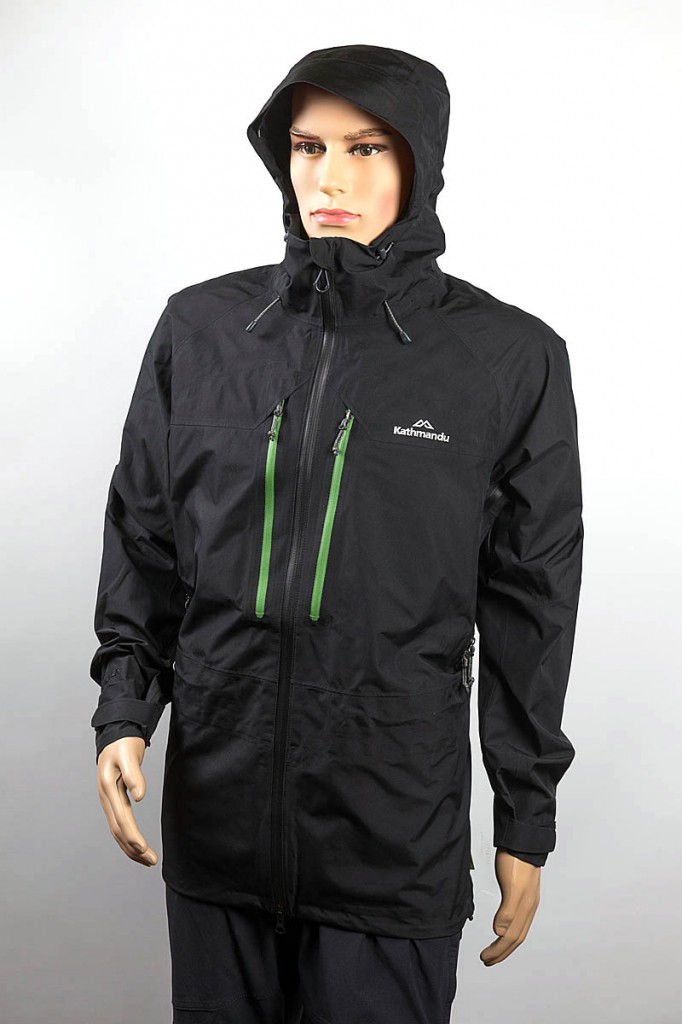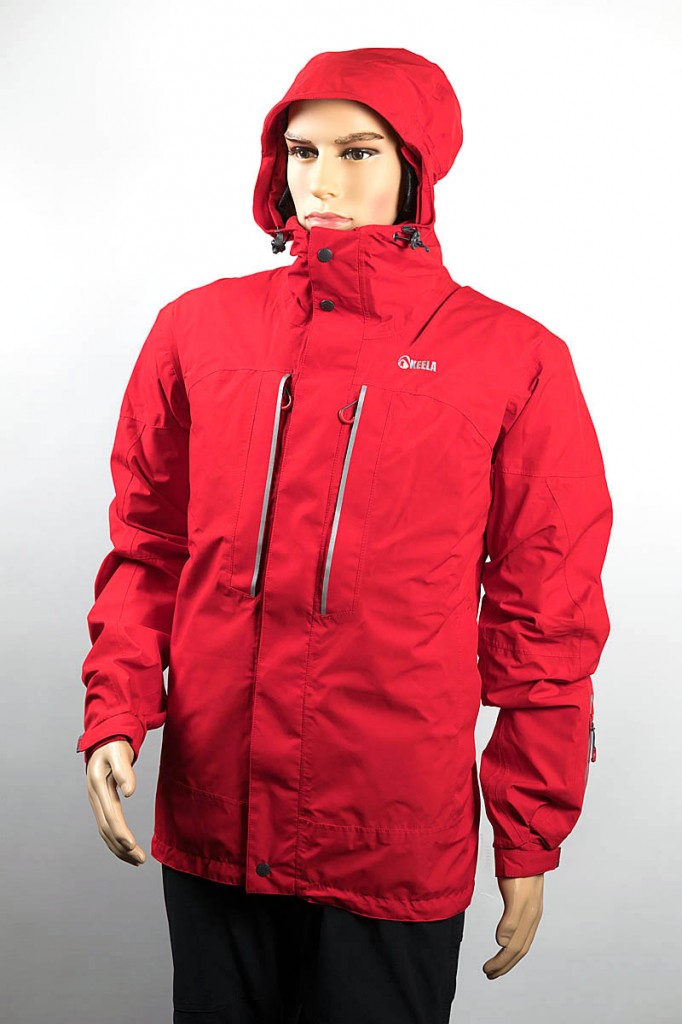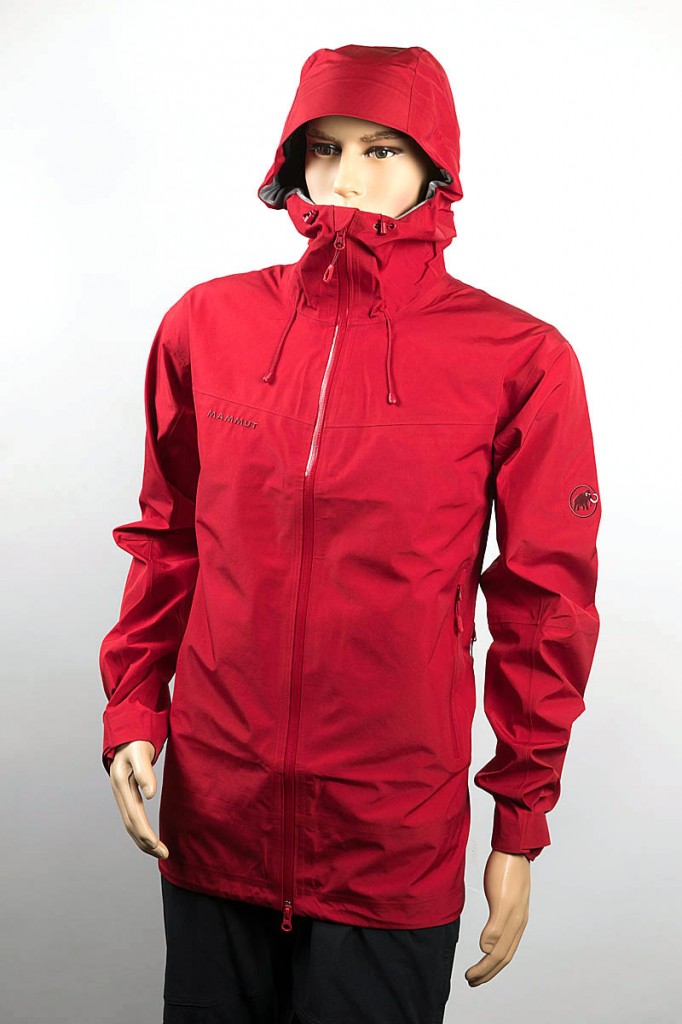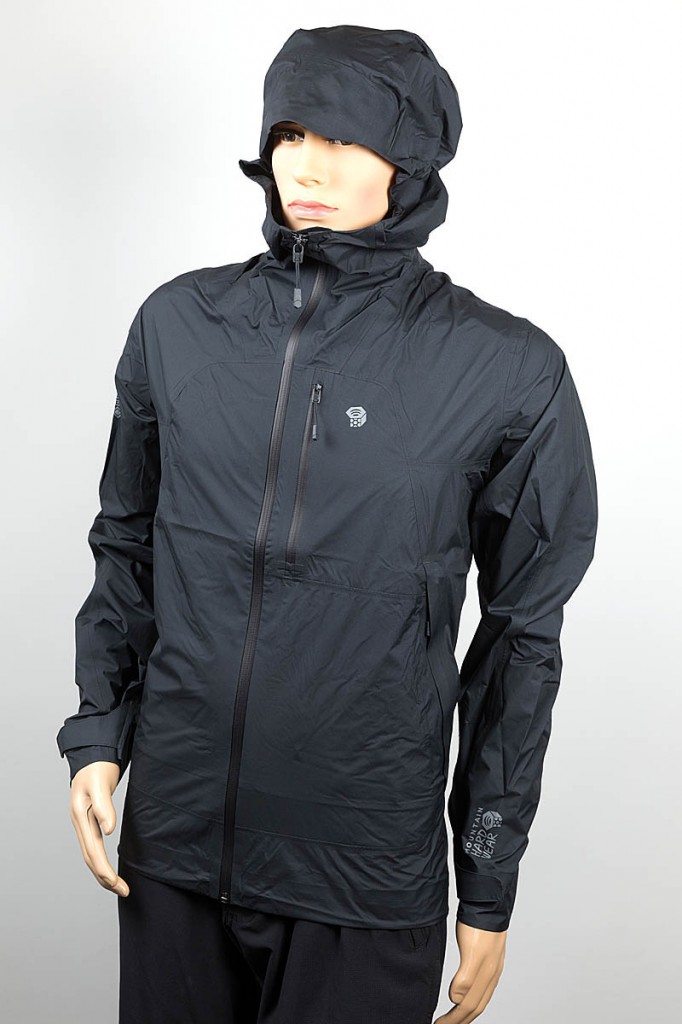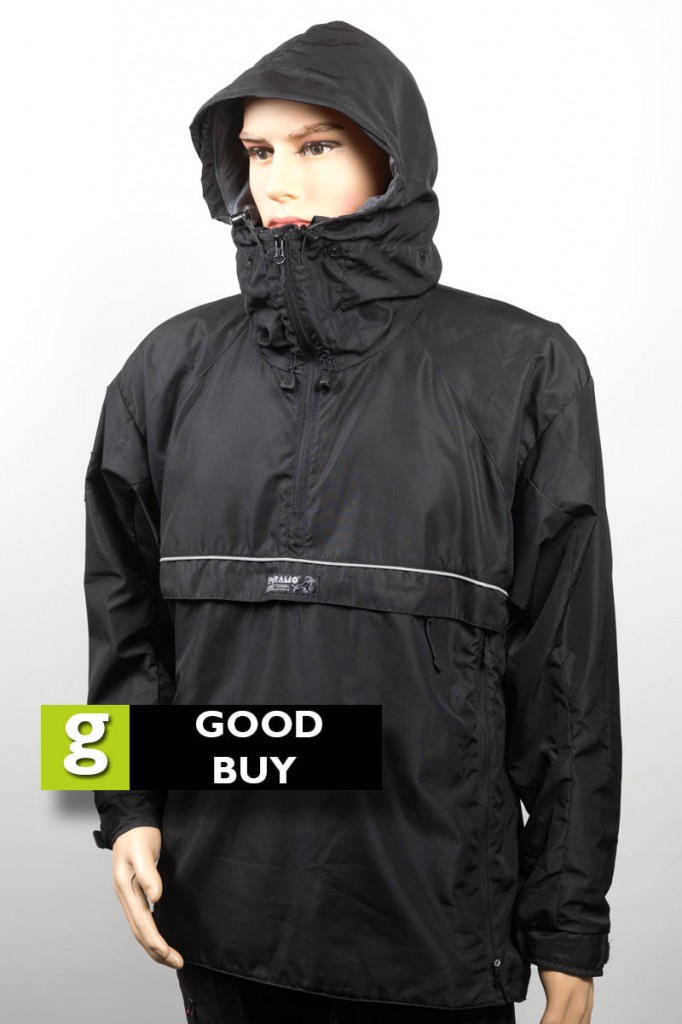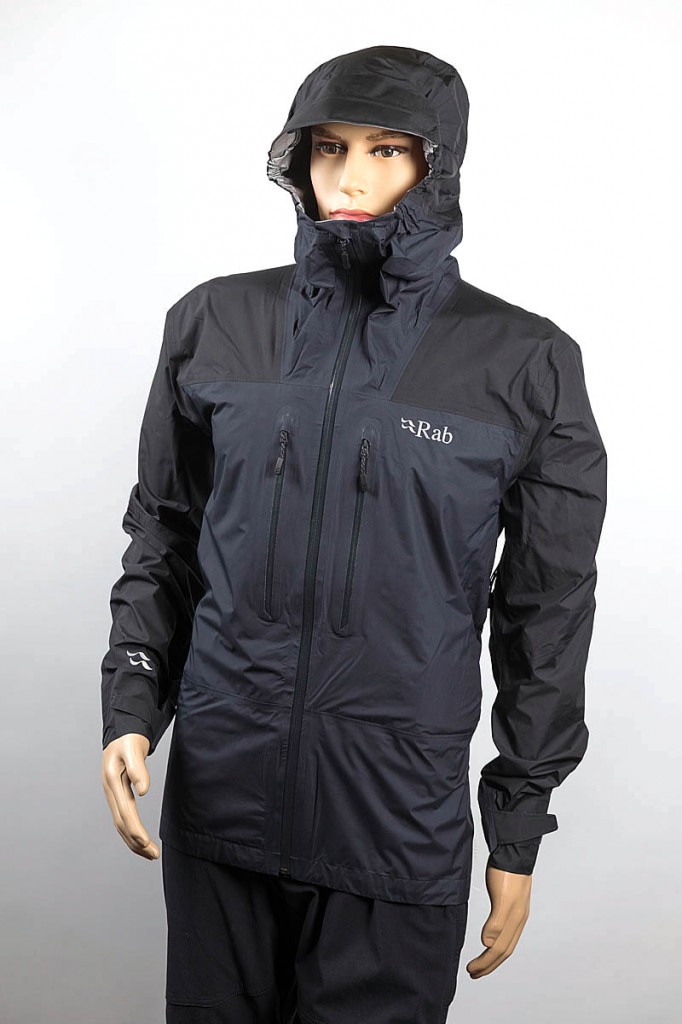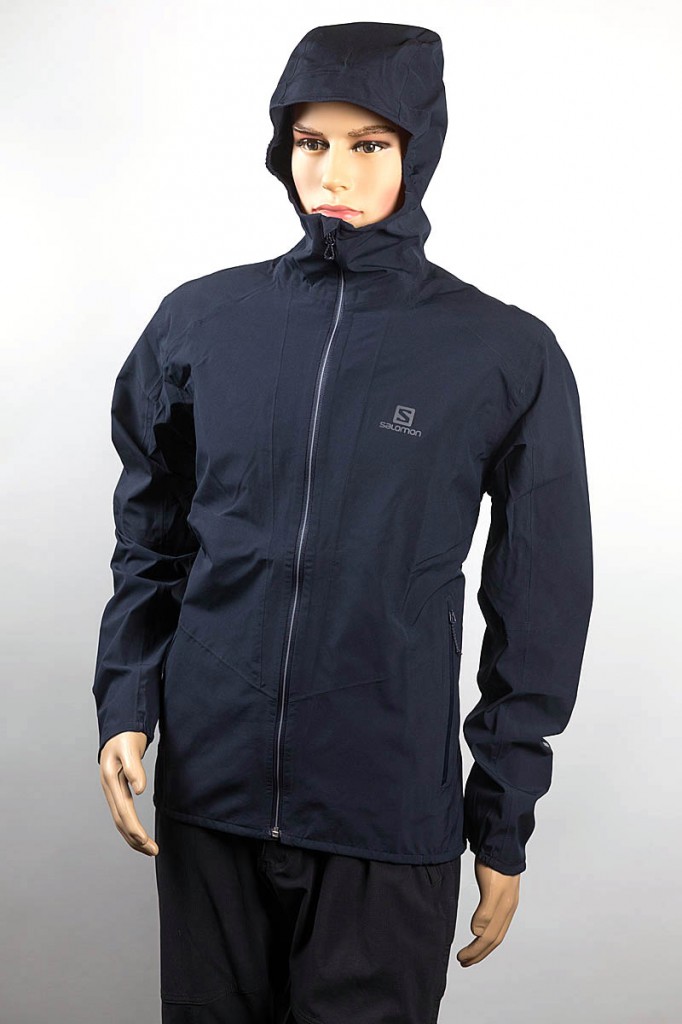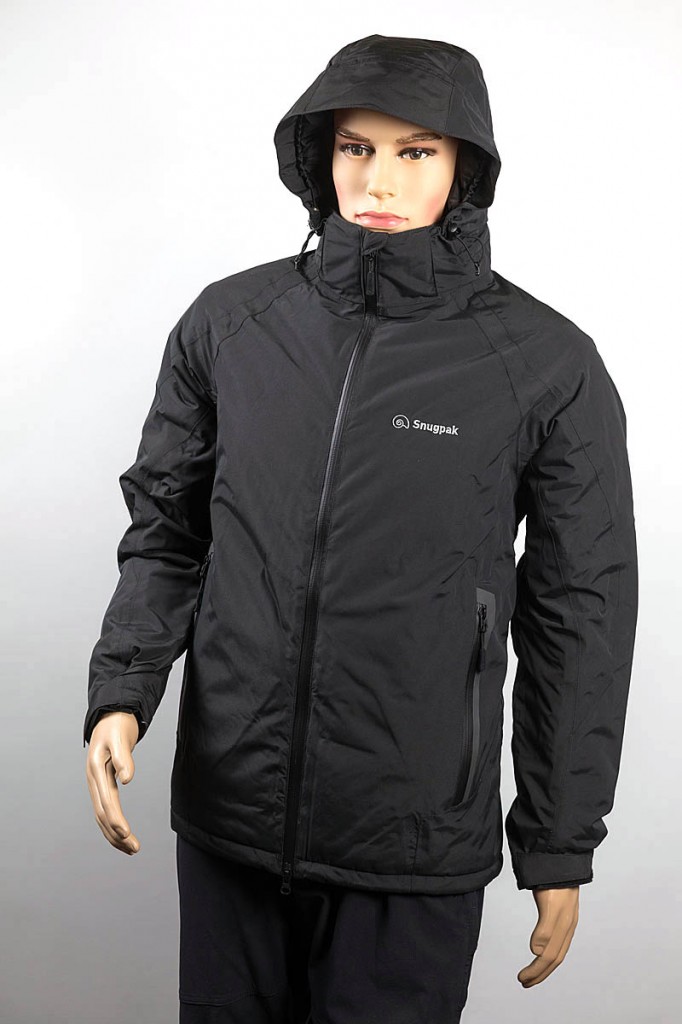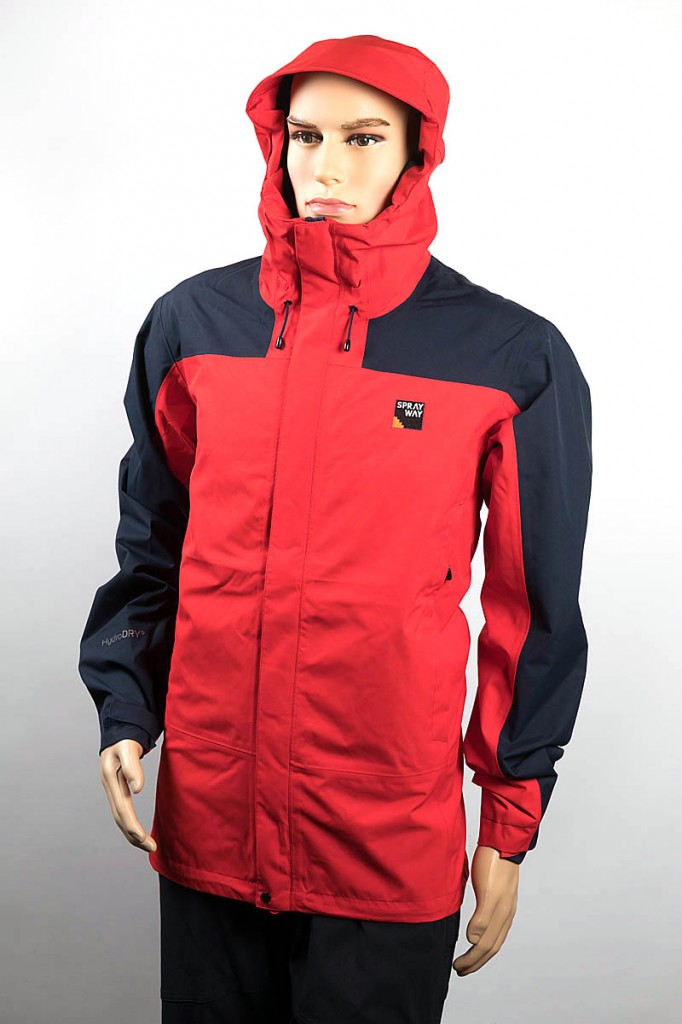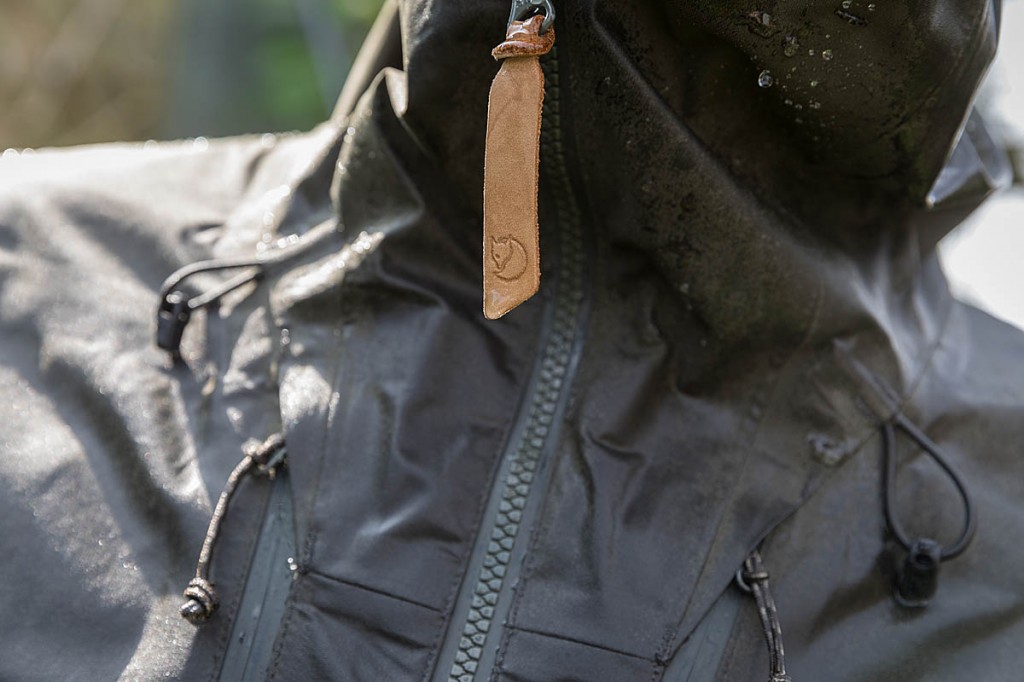This test of waterproof jackets took place over an extended period, because it began before the imposition of the lockdown, which restricted access to routes we would normally use to evaluate clothing.
As lockdown eased, we were able to get out on the hills again and continue testing. So the jackets in the test were used in a wide variety of conditions.
The jackets range from very lightweight to much more substantial insulated garments.
We rated them for how well they perform at keeping out the weather; how well they managed to shift the perspiration that inevitably builds up inside the jacket when making hill and mountain ascents. We also evaluated their overall comfort: how the design enabled movement and how the lining felt against the body, plus whether the hoods provided a comfortable fit. We also rated the jackets for their useful features, overall quality and value for money.
There’s a big spread of costs for the jackets, from modestly priced waterproofs to some quite expensive ones.
In testing the jackets, we’ve had in mind using them on the UK hills, mountains and in the countryside, but many of them didn’t look out of place when heading to the pub or in to town for the shopping.
So it’s important when choosing a waterproof to match its qualities and features to your intended use and, of course, your budget.
Arc’teryx Zeta AR Jacket
Price: £400
Colour: black
Weight: 451g
Material: nylon
Waterproofing: Gore-Tex with Gore C-Knit Backer
Country of manufacture: China
Size: men’s S-XXL; women’s XS-XL
Recommended wash: 30C, no fabric conditioner
Women’s version: yes
The Zeta AR is a full-length walker’s jacket in a pared-down, minimalist design.
It uses three-layer Gore-Tex with Gore C-Knit Backer fabric, which was developed by Gore specifically with mountain walkers and trekkers in mind. The Arc’teryx jacket uses durable N70p nylon face fabric which was a bit noisy on the move.
Although the design is uncluttered, the make-up of the jacket is fairly complex to allow good mobility. The elbows are articulated and the underarm area has a gusset which helps stop the garment riding up when reaching up for holds or the top of stiles. There are generously sized pit zips with dual pullers which allow a choice of where to place your vent. The sleeves were quite long for the size, and the cuffs have hook-and-loop adjustment tabs. The cuffs are slightly scalloped on the palm side of the sleeve, allowing a small extended area of fabric over the back of the hand.
The jacket is quite long and has a scooped rear which covers the bottom well. The water-resistant main zip has a single puller – less convenient than a double one for adjustments on the move – but it does have a good length cord and plastic tab which were easy to use while wearing gloves. The zip is backed by a small storm flap to help keep out any moisture that might make its way through.
The zip length is good and, when fully fastened, sits just below the mouth on the face. There’s a small chinguard on the collar with brushed microsuede backing to help with comfort.
The hem has full-circumference drawcord adjustment with twin captive spring toggles.
The jacket has two hip pockets which sit just above the rucksack hipbelt area. Unusually, the pocket zips open upwards, which is useful if you want to use them as handwarmer pockets and partly close them. As with all the zips on the Zeta AR, these are WaterTight, and ran smoothly. They have good length cords which helped ease of use with gloves.
Inside each pocket is a drawcord with spring toggle for the rear waistband, which allows the jacket to be cinched in around the kidney area to keep out any updraughts.
There is also a small internal zipped pocket on the left side of the jacket, big enough to take a smartphone.
The StormHood, which has a laminated peak, has single halo cord adjustment to allow cinching round the face. The cord has a rear spring toggle for locking. It’s big enough to accommodate a helmet. It worked well when wearing a helmet, but without, the hood wasn’t the most comfortable. Cinching it in hard when walking into a strong headwind meant the hood had a tendency to press against the front of the ears. Also, because there is only the single cord adjustment, it leaves a slight gape at the lower end of the hood, allowing wind to penetrate around the bottom of the cheeks.
Wearing a hat or helmet under the hood made for better comfort. The peak is just big enough to protect the face when walking into a headwind.
The fit of the Zeta AR is tailored to the body. This allows layering underneath. The sizing of our large men’s sample was actually fairly generous.
The Arc’teryx jacket was among the lighter ones in the test, despite being quite long in the body. Minimalist design and clever use of lightweight features helped achieve this. The fabric, however, did feel robust enough to give good service and overall quality was very good, which is to be expected in a garment with this price tag.
Breathability when pushing hard uphill was good, and the Zeta AR kept the weather out. It was completely waterproof during our testing. The longer length gives good protection for the mountain walker and trekker. Windblocking was also very good. It’s a good choice for a committed hillwalker, though its one shortcoming was the hood which, though it turned well with the head, was not as comfortable as some and also couldn’t be cinched in completely around the cheeks, allowing some windblown wind to enter.
Arc’teryx has built in a few nice little design features and the jacket overall was comfortable and offered confidence of keeping out the worst of the weather on the UK’s mountains.
Performance 27/30
Breathability 25/30
Comfort 7/10
Features 7/10
Quality 9/10
Value for money 7/10
Total score: 82/100
Berghaus Paclite Peak Vented Jacket
Price: £180
Colour: red
Weight: 389g
Material: polyester
Waterproofing: Gore-Tex Paclite
Country of manufacture: Vietnam
Size: XS-XXXL
Recommended wash: 30C, non-bio detergent, no fabric conditioner
Women’s version: no
The Paclite Peak Vented Jacket is new this season from Berghaus and is a pared-down garment with no extraneous features, enabling it to tip the scales at less than 400g.
It’s a clean design, with its main water-resistant zip with a single puller backed by a storm flap. There’s a softer fabric chin guard at the top of the zip and the collar is quite high, reaching the mouth level when the zip is fully closed.
There are two zipped hip pockets which sit just above the rucksack hipbelt or harness level. There is also a small zipped pocket on the inside of the jacket on the left chest, which is big enough for a phone.
As is evident from the jacket’s name, it has two pit zips to allow venting. These have water-resistant zips with a cord on the puller to make them easier to adjust while wearing gloves. The jacket hem has drawcord adjustment around its full circumference with twin spring-toggle locking.
The hood is big enough to use with a helmet and has a laminated peak. There’s a single halo-type volume adjuster with spring toggle locking at the rear of the hood.
The Paclite Peak Vented Jacket is medium length.
It uses Gore-Tex Paclite waterproof fabric, a two-layer material that is designed to minimise weight and maximise packability. The durable water-resistant treatment on the shell is PFC free and the jacket uses bluesign fabrics, and is part of Berghaus’s MadeKind range that includes features designed to be kinder to the environment.
The Berghaus jacket stood up well to constant rain driven by gale force winds and kept the water out. The hood did cinch in enough to keep it snug into the cheeks in a headwind. It has two shockcords, one for each side, and getting the hood properly adjusted means trying to pull both by an equal length, which was a bit of a lottery when wearing gloves.
The peak is just big enough to keep out wind-driven rain when walking into a headwind, once the hood volume was adjusted correctly. The chinguard wasn’t over effective and the zip puller could be felt against the chin when the hood was tightened. The collar top is just below the bottom of the mouth when the hood is pulled in.
The sleeve cuffs are flared enough to allow them to go over winter gloves and form a good seal.
Breathability was reasonably good from the Paclite fabric. It also kept the rain out well, but the Paclite Peak Vented Jacket is purely a shell jacket and doesn’t provide any extra warmth. The material feels fairly soft and wasn’t too noisy. Opening up the pit zips helps let some air into the jacket, and there was very little ingress of rain when they were open.
The two hip pockets were usable when wearing a rucksack hipbelt, but the inner pocket is very small – not big enough for a smartphone, but it will take a compass.
Movement wasn’t constrained when reaching up for holds on scrambly routes or over stiles.
The Berghaus jacket has nice clean lines and its simple design and use of Paclite fabric keeps its weight below 400g and makes it easily packable in the rucksack. Quality was good.
Performance 26/30
Breathability 24/30
Comfort 7/10
Features 7/10
Quality 8/10
Value for money 8/10
Total score: 80/100
Craghoppers Caleb Jacket
Price: £175
Colour: black
Weight: 538g
Material: polyester
Waterproofing: Gore-Tex
Country of manufacture: China
Size: S-XXL
Recommended wash: 40C
Women’s version: no
The Caleb is described by Craghoppers as a smart choice for the urban trail.
It offers Gore-Tex waterproofing at a more affordable price in a simple design. The jacket is medium length and its polyester face fabric isn’t too rustly.
The full-length water-resistant zip is backed by a storm flap with gutter. The zip has a single puller, so can’t be opened up from the bottom for any adjustments. The puller has a short cord and small plastic tab to help when wearing gloves.
The collar is fairly high, with the top of the zip reaching the mouth. There’s a tricot lining at the chin area. The sleeves have hook-and-loop adjustment tabs at the ends, slightly extended over the back of the hand. The elbows are articulated slightly.
The lining of the jacket is a separate sewn-in polyester layer, rather than bonded to the back of the face fabric. The hem has a full-circumference drawcord with twin spring toggle adjusters.
The Caleb has two zipped hip pockets, covered by a sizable storm flap. The pullers have short cords to help use with gloves.
There’s a small internal zipped pocket, large enough to accommodate a smartphone.
The sleeves are articulated and the cuffs have hook-and-loop adjustment strips, but the cuffs are quite narrow which made it very difficult to get them over thick gloves.
The hood has a laminated peak and a rear halo adjuster with spring toggle locking. There are also two front adjusters allowing the hood to be cinched in around the cheeks. These have small slotted plastic lockers which were fiddly to use when wearing gloves.
The hood turned well with the head when cinched in and it was also big enough to use over a helmet. The zip puller could be felt against the mouth and chin when fully closed and the hood tightened in. The peak was big enough to give some protection to the face when head down into strong winds and rain. The hood did keep the rain out when cinched in.
The lining made for a slightly warmer initial feel to the jacket, but it did also contribute to a build-up of moisture, particularly when heading uphill on cold days. The Caleb kept the rain and sleet out during our testing.
The interior pocket is less convenient to use than an external one, as you have to unzip the jacket to get at it, and the pocket’s zip puller is small, making it more difficult to grasp when wearing gloves.
The positioning of the hip pocket is good for handwarming, but they are partly covered by a rucksack hipbelt, making them less useful for placing items in when wearing a pack.
The Craghoppers has a clean design and kept the weather out, while offering a little extra warmth than some shell jackets. It was among the more affordable in the test offering Gore-Tex waterproofing.
Sizing was about average.
Performance 24/30
Breathability 23/30
Comfort 7/10
Features 7/10
Quality 7/10
Value for money 8/10
Total score: 76/100
Fjallraven Keb Eco-Shell Jacket
Price: £450
Colour: green
Weight: 516g
Material: recycled polyester
Waterproofing: Eco Shell membrane
Country of manufacture: China
Size: men’s XS-XXXL; women’s XXS-XXL
Recommended wash: 30C mild liquid detergent
Women’s version: yes
The Keb jacket uses the Swedish brand’s three-layer Eco-Shell material, which combines a face fabric made from partly recycled polyester; a hydrophilic membrane; and a tricot backing fabric.
Our green-coloured sample garment also came with impressive green credentials. The use of part-recycled polyester is obviously less wasteful than new material. It’s also impregnated with a durable water-resistant treatment that doesn’t contain perfluorocarbons, which are a cause for concern both in the environment and the body.
Fjällräven says the use of a hydrophilic, rather than hydrophobic membrane encourages the passage of perspiration outwards from the body.
The fabric isn’t too noisy in use and has a slightly softer feel.
It’s a fairly long jacket with minimalist design with nods to traditional Scandinavian design. There are pleats at the lower chest which act as a small bellow for its pockets, and Fjällräven’s branded leather tag on the zip puller, plus the leather arctic fox logo on the shoulder.
The Keb Eco-Shell is middling in weight and the fabric feels robust.
The full-length Aquaguard main zip is quite a beefy one and has a stormflap backing and press stud fastening at its base. There’s a soft tricot chinguard lining. The collar is high and covers the mouth when the zip is fully closed. The zip has dual pullers to enable it to be partly opened from the bottom – useful when adjusting inner clothing layers and trousers. The main puller has, as mentioned, a leather tag and the other one a short cord.
The sleeves are articulated and have hook-and-loop adjustment at the cuffs, which have a small extended area for the back of the hand. The cuffs were flared enough to allow them to go over thick winter gloves with little difficulty. The armpit areas have gussets to prevent riding up when reaching up. There’s a zipped pocket on the upper arm of the left sleeve, which is just about big enough for a compass.
In persistent rain and sleet, the precipitation initially beaded as normal on the shell, but parts did then wet out on the surface. No water got through, however, and breathability was maintained. The jacket shifted perspiration well.
The Keb Eco-Shell has two zipped chest pockets, sited high up on the jacket, clear of the harness or rucksack hipbelt area. These are large enough to take a laminated OS map. Each pocket also has a small inner stretch mesh pocket for slotting a phone or music player in, and a cord exit into the jacket.
There’s another medium-sized internal zipped stretch mesh pocket on the left side of the chest.
The jacket hem has a drawcord adjustment with twin spring toggles to secure it.
The Fjällräven jacket has zipped side vents rather than pit zips. These run from just below the armpit slightly diagonally to the side seam. In persistent rain we found they allowed cooling air into the jacket with virtually no ingress of water. The vents have twin zips so, if you’re faced with strong driven rain from a side wind, you can move the lower puller up so most of the vent is protected by the sleeves and arms, while still maintaining some cooling.
The hood and collar work well. There’s a soft chinguard and also a similar strip of tricot material at the back of the neck for added comfort. The hood has a halo adjuster for volume and side adjusters that allow the hood to be gathered in close to the cheeks in a headwind. These latter adjusters can be cinched in with a simple pull of the drawcord loop at the collar and slackened by pressing hidden spring buttons. The halo drawcord has a rear spring toggle housed under a small cowl.
The hood will accommodate a helmet.
The Fjällräven Keb Eco-Shell comes at a top price, but for that you get quality and good design, along with a jacket that has good environmental credentials.
The jacket worked well for mountain and hill walking, and is also suitable for activities such as ski-touring. It performed very well in wet and cold conditions, yet its muted colours and minimalist design don’t shout ‘outdoors’ and the Keb Eco-Shell is equally at home on the high street when protection from the elements is needed.
It has lots of nice little design elements that indicate the brand understands the needs of the hillwalker and trekker. The slight stretch in the fabric meant movement wasn’t restricted when on the hill. Fit was on the slightly larger side of average.
Performance 26/30
Breathability 25/30
Comfort 8/10
Features 8/10
Quality 9/10
Value for money 7/10
Total score: 83/100
Jack Wolfskin Chilly Morning Men’s Jacket
Price: £130
Colour: black
Weight: 792g
Material: polyester
Waterproofing: Texapore
Country of manufacture: Bangladesh
Size: men’s S-XXL; women’s XS-XXL
Recommended wash: 30C
Women’s version: yes
The Chilly Morning Men’s Jacket comes from Jack Wolfskin’s winter collection and combines waterproofing with insulation.
Styling is clean. The jacket is fairly long, with two zipped hip pockets with storm flaps, and a contrasting main zip with single puller, which has an interior flap to keep out wind and rain. There’s a tricot-lined chinguard and the jacket’s solid lining is quilted. The hip pockets are also tricot-lined to provide extra comfort and there’s an additional interior zipped chest pocket on the left side, large enough to take a smartphone.
The hem has drawstring adjustment with spring toggle fastening. The sleeves have adjustable cuffs with hook-and-loop strips to secure the tabs.
The hood has both a rear halo-type adjuster and front drawcords at the sides, and worked well, staying in place in a headwind and blocking the wind, and also turning well with the head. It did accommodate a helmet.
Out on the hill, the Texapore waterproofing, which has a hydrostatic-head rating of 10,000mm, kept out the rain. As you would guess from its name, the jacket is warm, so not a good choice on warm summer days, but on cool spring days and even on wild cooler summer days the Chilly Morning Men’s Jacket (there is also a women’s version and the jacket can also be worn in the afternoon and evening!) provided a good degree of insulation and protection against the elements. Windblocking was very good.
Breathability was reasonable, though with the insulation it did make for a warm experience on uphill stretches.
The insulation tips the Jack Wolfskin jacket towards the heavier end of jackets in the test, but the added warmth is useful on colder days. The Microguard insulation is synthetic, so wasn’t affected noticeably by damp.
Price is competitive too. Sizing was about average.
The Chilly Morning jacket is ideal if you want a warmer shell jacket for those spring or autumn days when the temperature dips, or even on a cooler evening on a summer camp.
Performance 25/30
Breathability 23/30
Comfort 7/10
Features 7/10
Quality 7/10
Value for money 8/10
Total score: 77/100
Kathmandu Aysen Jacket
Price: £140
Colour: black
Weight: 435g
Material: polyester
Waterproofing: Gore-Tex Paclite
Country of manufacture: China
Size: men’s S-XL; women’s 8-16
Recommended wash: 40C no fabric conditioner
Women’s version: yes
The Kathmandu jacket uses Gore-Tex Paclite, the two-layer waterproof fabric, constructed with an outer shell with durable water-resistant finish, bonded on to the Gore-Tex membrane.
The jacket is quite long, but still keeps the weight relatively low.
It has a clean design, with the water-resistant zip, which has double pullers, backed by a storm flap and a tricot-backed chin guard. There are two large chest pockets, big enough to take an OS map, with contrasting coloured waterproof zips. These are placed above the rucksack waist strap area. Inside each of them is a drawcord for cinching in the waist to help keep out updraughts. The hem can also be adjusted via two drawcords. There is also a smaller internal zipped chest pocket, big enough for a smartphone and with a cord exit into the interior of the jacket. The pocket also has a plastic key loop in it.
The sleeves are articulated and cuffs are adjustable using tabs with hook-and-loop fastenings. There are also sizeable pit zips under each sleeve, with water-resistant zips with double pullers. These allow a good variety of ventilation, which we found useful in conditions varying from cool spring hill days to warmer walks on summer outings. There was little or no ingress of rain when the pit zips were opened.
The hood worked well and accommodated a helmet if needed. It has a rear halo adjuster and two side adjusters with tethered drawcords. This meant it was possible to cinch the hood in around the head and face and, when walking into a headwind, it kept out the rain. It also turned well with the head. The only minus point is that the rear drawcord adjuster sits under a little cowl and works by locking it by pulling the cords down, with an upward tug to release them. This was a little fiddly, especially when wearing gloves.
The Aysen worked well for general hillwalking. It has the features you need to keep out the weather. Breathability was quite good and the Kathmandu jacket represents good value for money for a Gore-Tex jacket. Weight was good too, as was quality. Fit was fairly generous.
Performance 25/30
Breathability 25/30
Comfort 8/10
Features 8/10
Quality 7/10
Value for money 8/10
Total score: 81/100
Keela Stratus SDP Shell
Price: £175
Colour: red
Weight: 892g
Material: polyester
Waterproofing: System Dual Protection
Country of manufacture: not stated
Size: XS-3XL
Recommended wash: 30C pure soap
Women’s version: no
The Stratus jacket is a traditional waterproof, Keela’s development of its Cumulus MR Pro garment, and uses System Dual Protection, a two-layer construction the brand has designed to minimise condensation inside the jacket.
Keela likens its SDP system to a kind of double-glazing set up, with an inner breathable lining with hydrophilic membrane, combined with an outer shell using the company’s Innovation 10 fabric.
The design creates a warm air pocket between the layers, which the brand says helps maintain body temperature during less active periods.
The lining is a close-knit mesh that is designed to draw moisture away from the body.
The double-layer construction makes for quite a beefy jacket and the Stratus is the heaviest non-insulated garment in the test.
It’s a bells-and-whistles design, packed with features. The jacket is quite long, providing good protection on the hill. The main zip has double pullers, enabling it to be unzipped from the bottom to give access to trousers. The water-resistant zip is covered by a stormflap on each side, one with a gutter, secured by a series of press-studs. These are a bit fiddlier than a hook and loop fastening. There’s a tricot-lined chin guard at the top of the zip.
There are two zipped hip pockets, plus two chest pockets which have reflective edging. Inside the left one is a d-ring on a short webbing strap. The right pocket has a webbing strap with a little detachable loop on the end, handy for items such as a compass.
Inside the Stratus, there’s another zipped pocket, which is big enough to take an OS map. Alongside the pocket’s zip is a pen holder.
The Keela jacket’s hem is adjustable via a drawcord with spring-toggle fasters. The jacket has shortish pit zips with double pullers so they can be opened from either end. The pit zips are covered by storm flaps held in place by hook-and-loop strips. These tend to limit the amount of opening and therefore the flow of air to vent the inside of the jacket.
The Stratus’s sleeves are articulated and have hook-and-loop adjustment tabs. The left sleeve has a small pocket with water-resistant zip, big enough to accommodate a smartphone. The zip opening has reflective edging.
The hood is big enough to wear with a helmet, and has both a rear halo adjuster and side drawcords, all secured by spring toggles. There’s also a wired peak. The hood worked well, turning with the head and also able to be cinched in enough to keep out the weather while walking into a headwind. The hood can be rolled down and secured with a flap with press-stud closure.
The Keela jacket is a rugged-feeling conventional jacket that gave good protection on the hill. Its double-layered construction makes for quite a warm garment, evident when working hard on uphill sections, but the Stratus did shift moisture outwards during less strenuous activity. The slight insulation from the SDP system was an advantage on cold days, and the condensation effect was lessened.
Comfort was reasonable, though if weight is a key factor in your choice, this Keela jacket is probably not for you. There’s a host of features on the jacket, which is ideal for long days in the mountains, especially on cooler wet days.
Performance 24/30
Breathability 26/30
Comfort 7/10
Features 9/10
Quality 7/10
Value for money 8/10
Total score: 81/100
Mammut Crater Hooded Jacket
Price: £179
Colour: red
Weight: 568g
Material: polyester
Waterproofing: Gore-Tex
Country of manufacture: China
Size: men’s S-XXL; women’s XS-XL
Recommended wash: 30C
Women’s version: yes
The jacket in the test is being superseded by a new version of the Crater, with a new cut and slightly improved breathability. The new Crater jacket retails at £300, but this version is on sale at the discounted price stated.
The outer shell of the Mammut waterproof is fairly stiff and rustly polyester with a slight sheen, and the three-layer construction has a Gore-Tex membrane. The lining is also polyester.
The design is fairly long with a clean set of features. The main water-resistant zip has double pullers so can also be opened from the bottom, and is backed by a storm flap. There’s a tricot chin guard for comfort.
The hem of the jacket has drawcord adjustment and the sleeves are articulated with hook-and-loop tabs for adjustment at the cuffs. There are good length water-resistant pit zips but these have just a single puller so can only be opened from the bottom up, which made for a slight gape at the chest area when fully opened, though there was no ingress of rain.
The Crater has two hip pockets with water-resistant zips. Inside the jacket there’s another smaller zipped pocket. The exterior pockets sit above the rucksack hip belt or harness area.
The hood is a good size, large enough for use when wearing a helmet. It has a rear halo adjuster plus two side drawcords, all with spring toggles. The hood has a good sized semi-stiffened peak. The hood cinched in well and turned with the head.
The Mammut jacket felt robust, with tough fabric that kept out the weather. Breathability was good and the jacket allowed movement when on more technical ground.
It’s a simple design but worked well on the hill and the Gore-Tex construction kept out the rain and wind. The cut was fairly generous.
The Mammut Crater is also bluesign and Fair Wear approved.
Performance 26/30
Breathability 25/30
Comfort 7/10
Features 7/10
Quality 8/10
Value for money 8/10
Total score: 81/100
Mountain Hardwear Exposure 2
Price: £315
Colour: dark blue
Weight: 271g
Material: nylon
Waterproofing: Gore-Tex Paclite Plus
Country of manufacture: Vietnam
Size: men’s S-XL; women’s XS-XL
Recommended wash: 40C, liquid detergent
Women’s version: yes
The jacket is the updated version of the Exposure 2 and is the lightest jacket in the test, using a Gore-Tex Paclite Plus two-layer construction, with the waterproof laminate bonded to an outer nylon shell fabric treated with a PFC-free durable water-resistant coating.
The jacket is fairly long and is a minimalist design to keep weight to a minimum. The fabric is quite rustly but there’s no stiffness in the material due to its very lightweight construction. The jacket did ride up a little when reaching up for holds.
The Exposure 2, a very dark blue, almost black, has a PFC-free durable water resistant treatment on its nylon face. The single-puller main zip is water-resistant and there’s a tricot-backed chin guard at the top.
The Mountain Hardwear jacket has a scooped back and, the hem can be cinched in with a drawcord with a single concealed spring button release.
The Exposure 2 had a fairly loose cut, handy for use over layers on cooler days, as there’s very little insulation from the lightweight fabric. It does block the wind well, however, and breathability was quite good.
The sleeves are articulated and cuffs have hook-and-loop tabs for adjustment. There’s a short cowl shape to protect the back of the hand a little.
The jacket has one chest pocket with a water-resistant zip. This is big enough to accommodate a smartphone. There are also two hip pockets with conventional zips, water-resistant, but they are protected by a storm flap. These pockets sit in the area covered by a rucksack hipbelt or harness.
The hood has a peak, which has a little stiffening but not enough to stop it being flattened against the forehead in a strong wind. There’s a single drawcord halo adjuster which pulls the hood in well but leaves the sides exposed letting in wind and rain. It did turn well with the head.
However, in strong headwinds the hood didn’t perform well. Even when cinched in hard it left quite large gaps at the side of the head. This allowed the wind to make the hood balloon out. The halo drawcord then began to loosen because the spring toggle didn’t hold the slender cord.
The lining felt reasonably comfortable against the skin and the Exposure 2 is so light it added hardly any weight to the rucksack. It also packs down small. The Paclite Plus fabric provided good breathability, if not quite up to the standard of some of the other Gore-Tex materials, but the weight saving and packability are big plus points especially on summer mountain days when you want to travel light.
If you’re looking for a waterproof that will keep out the wind and rain but will add less than 10oz to your pack, the Exposure 2 is a good choice. The disappointing performance of the hood in high winds was the jacket’s main drawback.
Performance 24/30
Breathability 25/30
Comfort 8/10
Features 7/10
Quality 8/10
Value for money 7/10
Total score: 79/100
Páramo Velez Adventure Smock
Price: £250
Colour: black
Weight: 801g
Material: polyamide
Waterproofing: Nikwax Analogy
Country of manufacture: Colombia
Size: men’s S-XXL; women’s XS-XL
Recommended wash: Nikwax Tech Wash
Women’s version: yes
The Páramo garment is different in two ways: first, it’s a smock design with a quarter zip, so goes on over the head; second, it uses the brand’s directional system to keep you dry, rather than the conventional membrane.
It’s a weighty top due to the double-layer construction. This also makes it one of the warmer tops. The nylon fabric is soft to the feel and less noisy than some of the thinner shell jackets. The outer material uses Nikwax PFC-free chemicals for its water-repellency and the thicker inner lining helps shift water and moisture outwards away from the body.
This is the key to the Páramo system, which relies firstly on the outer layer shedding rain but also on the inner layer transmitting water outwards, rather than it condensing inside the jacket with the resultant cooling clamminess.
To help keep moisture down, there are two zipped side vents running from hem to chest level. These have double pullers so can be opened either from the top or bottom or even a combination of the two. They are backed by storm flap to help keep out wind and rain when closed and also adding a little protection when opened. The vents have a press-stud closure at the bottom which stops the smock flapping about if you open them fully from the bottom.
The vents do provide a good amount of air to the body when opened, particularly on windy days, though there is the risk of rain ingress, especially if driven by a side wind.
The main zip, which runs from chest to chin, is also backed by a storm flap, which has two press-stud closures so, again, this can provide some venting by fastening the studs while unzipping the smock.
The hem is scooped down at the back and can be cinched in using two drawcords with spring-toggle fasteners.
The smock has a large chest pocket with a horizontal zip, protected by a storm flap. There is also a large, lower pocket inside the smock, with access via zips at either end. This is accessed by opening the vent which then allows the pocket zip to be opened. The pocket is big enough to take an OS map. It also has a tricot lining so can be used as a handwarmer pocket with by opening the vent zips and the pocket zips.
The sleeves are elasticated and have hook-and-loop tabs on the end of elasticated sections to adjust the cuffs.
The hood can be rolled down when not in use and is secured by six press-studs. In use, the soft fabric made for a comfortable fit. It has a rear single drawcord volume adjuster and two side adjusters at the front, with tethering for excess cord. The hood has a wired peak and is large enough to use while wearing a helmet. It turns fairly well with the head.
The Páramo Velez Adventure Smock was comfortable in use and the lining didn’t feel clammy when working harder uphill. It wasn’t completely windproof, with some sneaking through in strong winds.
There’s extra lining depth in the shoulder and back areas where rucksack straps are likely to be positioned.
It did keep out driven rain and breathability was good.
The jacket did ride up a little when reaching up, as the material isn’t stretchy.
The hood worked well. There’s only a limited amount of rear volume reduction from the cord, but the two side cords enabled it to be cinched in well into the face, though the spring toggles on the adjustment cords sit fairly close to the chin.
The sleeve cuff adjusters worked well too, with the elastication enabling a good snug fit.
The smock has reflective strips on the back and chest.
Because there’s no membrane, the Páramo smock will let in water if, for instance, you sit on it on wet rock or grass, or lean against a wet surface. The brand says its directional waterproofing is tested to keep out rain in typical UK conditions for four hours. While on test, the Velez Adventure Smock kept us dry. Although quite a warm top, with the resultant build-up of perspiration, it does eventually shift the moisture outwards, helping maintain temperature.
The Páramo smock has lots of nice little design features and was comfortable throughout testing. It’s less convenient to put on or take off than a jacket with full-length zip, but the smock does provide a snug feeling on the hill.
It also has good green credentials and is manufactured in the Miquelina Foundation factory in Colombia.
Performance 24/30
Breathability 27/30
Comfort 8/10
Features 8/10
Quality 8/10
Value for money 7/10
Total score: 82/100
Rab Zenith Jacket
Price: £250
Colour: dark blue/black
Weight: 334g
Material: polyamide
Waterproofing: Gore-Tex Paclite Plus
Country of manufacture: China
Size: men’s S-XXL; women’s 8-16
Recommended wash: 40C liquid detergent
Women’s version: yes
The Zenith is a lightweight waterproof that uses Gore-Tex Paclite Plus fabric. The material is 13 denier polyamide with 20 denier reinforcement in higher-wear areas such as the shoulders.
It has a simple, clean design, with just two chest pockets that have water-resistant zips. These are big enough to take an OS map.
The main zip is water-resistant too and has a storm-flap backing. There’s a single puller. The jacket’s hem is adjustable via a drawcord with twin buried spring buttons to lock it. The rear hem is scooped lower.
The Rab jacket has water-resistant pit zips to provide ventilation. These have double pullers co can be opened either from the top or bottom.
The sleeves are articulated and the cuffs have hook-and-loop strips for adjustment. There are small cuff extensions to cover the back of the hands.
The hood has a semi-stiffened peak and is also wired. There’s a single rear halo volume adjuster with a spring toggle lock on the elasticated drawcord. There are no front adjusters but the sides of the hood are elasticated at the bottom section. The hood can be rolled away and secured down with a narrow strip that has press-studs that fasten round the jacket’s external hanging loop. This is quite useful such a lightweight garment as a tail wind tends to make the hood flap up when not in use.
The cinched-in hood does let some wind and rain in at the sides, though the elastication does help a little. The hood drawcord did tend to press into the ears when tightened hard. The hood turned well with the head, and was big enough to use with a helmet. The main zip comes fairly high, covering the mouth when fully fastened.
Overall the jacket was comfortable, the lining face working well. It was windproof and kept out heavy rain during testing. Breathability from the Paclite Plus fabric was quite good.
The Zenith was one of the lightest jackets in the test and packed down well into the stuffsack that was supplied with it.
The Rab jacket is a no-fuss clean design that worked well on the hill. The lightness and good packability made it a useful choice on summer mountain excursions, providing a reliable waterproof shell when faced with heavy rain. The hood did let in some wind at the sides of the face, due to the single halo adjustment system, but the addition of extra drawcords would, of course increase the weight slightly.
Fit was average and styling was good though, like all the non-stretch shells, the jacket did ride up a little when reaching up for holds on technical terrain.
Performance 26/30
Breathability 25/30
Comfort 8/10
Features 7/10
Quality 8/10
Value for money 7/10
Total score: 81/100
Salomon Outline Jacket
Price: £180
Colour: dark blue
Weight: 322g
Material: polyester
Waterproofing: AdvancedSkin Dry 20K/20K
Country of manufacture: Bangladesh
Size: men’s S-XXL; women’s XS-XXL
Recommended wash: 30C no fabric conditioner
Women’s version: yes
The outline is a lightweight, minimalist jacket that uses a 2.5-layer construction. There’s an outer face with durable water-resistant treatment, which is then bonded to the waterproof layer. This has a print overlay – the ‘half’ layer – to help preserve the membrane.
The fabric has a slight stretch, which helps mobility.
At high-wear areas around the shoulders, upper arm and in the hood, there is a full three-layer construction with a lining fabric.
The design is simple and pared down. The main zip has a narrow backing storm flap to help keep out the weather. The hem doesn’t have a drawstring but is partially elasticated which keeps it snug to the body.
At chest level, there’s a small interior tab with press-stud fastening. This enables the jacket to be partly unzipped for venting, with the small strap stopping the jacket gaping too much in a headwind.
The jacket is fairly short, keeping it out of the way when stepping up on more technical terrain.
The sleeves are articulated and the cuffs have small cowls over the back of the hands and are partly elasticated. There’s a sizable Salomon logo on the left forearm.
The Outline has two hip pockets with water-resistant zips, though these are in the hip-belt and harness area.
The hood is again a simplified design, with no volume control. There are elasticated sections at the rear and each side of the face, and the hood has a semi-stiffened peak. It is big enough – just – to accommodate a helmet, but that does bring the top of the zip, which in normal use sits just below the mouth, upwards to cover the mouth.
The hood does turn with the head and, in a headwind, though it does get pushed back a little, it stays on the head. The lack of the ability to cinch it in tight around the face does allow some wind and rain to sneak in at the sides.
The removal of adjustments at hem, cuffs and hood have enabled the weight to be kept down – it’s the second-lightest jacket in the test. It also packs down well too.
The Salomon jacket is comfortable in use. The fabric feels quite soft and it’s not too rustly. Sometimes 2½-layer constructions can feel a little clammy against the skin, but the Outline felt OK. Breathability was quite good and the jacket’s AdvancedSkin Dry waterproofing kept out the weather.
The Salomon Outline’s clean and simple lines don’t immediately shout ‘outdoors’ so works well as a high street jacket, while still providing full waterproof protection in mountain conditions. The cut was fairly athletic.
Performance 25/30
Breathability 24/30
Comfort 8/10
Features 7/10
Quality 7/10
Value for money 7/10
Total score: 78/100
Snugpak Torrent Jacket
Price: £165
Colour: black
Weight: 964g
Material: nylon
Waterproofing: Paratex Dry
Country of manufacture: China
Size: XS-XXL
Recommended wash: 30C
Women’s version: no
The Torrent is an insulated waterproof jacket from the brand best known for its sleeping bags.
The Snugpak jacket has a nylon shell that uses the brand’s Paratex Dry waterproofing, and insulation is polyester Softie filling. The jacket is by far the warmest in the test, and is rated for comfort by Snugpak down to -5C.
The design if fairly simple. The jacket is medium length and the main zip is water-resistant and is also backed by a storm flap to keep out the wind and rain.
The hem is adjustable via a drawcord with twin spring-toggle locking. There are two hip pockets with water-resistant zips and the Torrent also has a medium-sized inside zipped pocket.
Sleeves are articulated and the cuffs have adjustment with hook-and-loop fastening strips.
There are pit zips with single pullers, so they can only be opened from the top. There is a storm-flap covering when they are closed. When open, there’s a stretch mesh backing. The pit zips are useful for providing some ventilation when moving uphill in what is a very warm jacket, though they’re not very long. There was no rain ingress when using them open in wet weather.
The jacket’s collar has tricot lining which helped comfort.
The hood can be detached using a zip and two hook-and-loop strips at each end. It is fully insulated and has a semi-stiffened peak. There is volume adjustment from a rear halo drawcord and spring-toggle lock and two front drawcord adjusters either side of the face. These enabled the hood to be cinched in well around the face and kept the wind and rain out. The hood did turn reasonably well with the head but it’s quite stiff because of the insulation it contains, so wasn’t quite as mobile as some of the other jackets.
The hood was big enough to accommodate a helmet.
The Torrent jacket was comfortable in use, with the nylon lining feeling OK against the skin.
The Snugpak jacket feels instantly warm when you put it on, which was great on cold mornings. The shell kept out the rain and blocked wind well. Not surprisingly, when pushing uphill there was a build-up of perspiration in such a warm garment, which took a little while to dissipate.
But for less arduous activity, the Torrent was reasonably breathable.
The Snugpak jacket is a good choice if you’re heading out in cold conditions or expect to be stationary for periods outdoors. It combines good insulation with a waterproof shell. The synthetic insulation material wasn’t compromised by moisture and the jacket kept its warming ability in all the test conditions.
All that warmth comes at the cost of weight and the Torrent was the heaviest and least packable jacket in the test, but that’s only to be expected with such a garment.
It’s not the first choice for the height of summer but when the temperatures dropped it was good to have both the warmth and waterproofing of the Snugpak jacket.
Performance 26/30
Breathability 23/30
Comfort 8/10
Features 7/10
Quality 7/10
Value for money 8/10
Total score: 79/100
Sprayway Hain Jacket
Price: £130
Colour: red/black
Weight: 644g
Material: polyester
Waterproofing: HydroDry
Country of manufacture: China
Size: men’s S-XXL; women’s 8-16
Recommended wash: 40C Grangers 2 in 1
Women’s version: yes, Oust Jacket
The Hain is a traditional waterproof jacket that uses Sprayway’s HydroDry waterproofing.
It’s fairly long and the fit is generous. The Sprayway jacket is one of the least expensive in the test, but has most of the familiar features you’d expect in a waterproof.
The polyester shell has a slightly soft feel and is not too noisy in use.
The main zip has a double puller and is covered by a double stormflap, secured by hook-and-loop patches. This makes it a little fiddlier than a straightforward water-resistant zip. There’s an additional press-stud at the bottom and the top of the zip has a tricot chinguard.
The hem is dropped at the rear of the jacket and has drawcord adjustment with two spring-toggle locks.
The lining is a mixture of solid taffeta and, in the back area, mesh, to help breathability.
The sleeves have small hand cowl extensions at the cuffs and hook-and-loop strip adjustment. The Sprayway jacket doesn’t have pit zips.
The Hain has two large hip pockets that sit mostly out of the rucksack hipbelt area. They have zip closures with storm-flap coverings. The pockets are big enough to take an OS map. There are drawcords within the pockets for waist adjustment.
Inside the jacket there’s a small pocket with a hook-and-loop tab for fastening.
The hood is large enough to use while wearing a helmet. It has a stiffened peak which is also wired, so it can be adjusted well when walking into the wind. There’s rear halo adjustment, plus two side drawcord adjusters at the front, enabling the hood to be cinched into the face to keep out rain and wind. The hood turns well with the head.
It can also be rolled down when not in use and secured with a strip with hook-and-loop patches. This can be tucked into a pouch inside the jacket when not needed.
The Hain kept the rain and wind out during our testing. Breathability was fairly good, but the lining isn’t the most comfortable, with a build-up of perspiration evident during uphill sections. The styling is conventional and the cut is standard.
It’s no lightweight and doesn’t pack down as small as some of the more expensive rivals in the test, but carries a modest price tag. On the hill, the Sprayway jacket kept us dry and has the features needed for mountain walking. It’s a little on the warm side for full summer days, but worked well on cool days on the hill.
Performance 23/30
Breathability 24/30
Comfort 7/10
Features 8/10
Quality 7/10
Value for money 8/10
Total score: 77/100
The Fjallraven Keb Eco-Shell Jacket topped the test, though it also headed the price list. Its overall performance, quality, features and comfort, along with good green credentials, made it our best buy.
Close behind were the Arc’teryx Zeta AR Jacket and the Páramo Velez Adventure Smock, two very different garments. The Arc’teryx jacket is lightweight and minimalist and gave great protection from the elements on the hill.
The Páramo, while strictly not a conventional waterproof jacket did keep the elements out and had lots of interesting little touches, working best in cooler conditions.
For colder days, the two insulated jackets offered both waterproofing and insulation, useful if you need that combination and the Jack Wolfskin top was good value for money.
- All the jackets in the test were supplied to grough by the brands.
